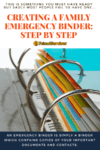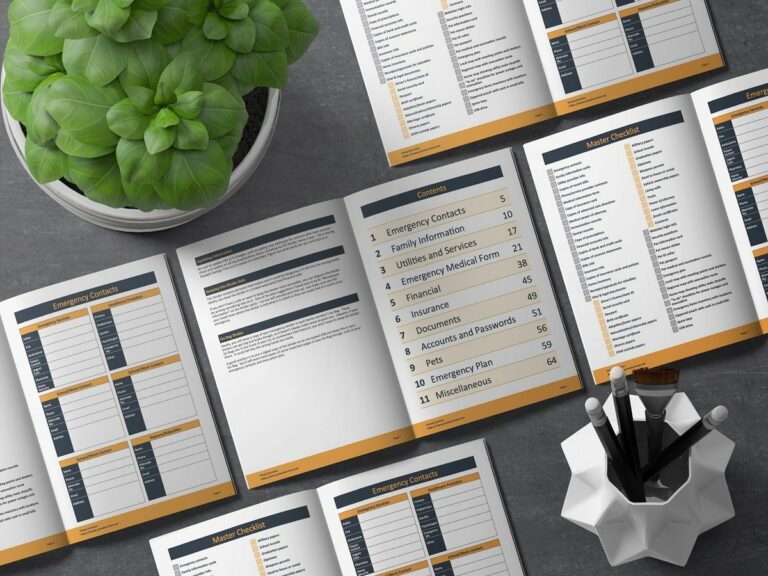Whether you are a hardcore prepper or just concerned about disaster preparedness, there is something that you absolutely must have ready to go in case of an emergency. Sadly, this is also what most people fail to prepare for.
It is an Emergency Binder.
What Is an Emergency Binder?
An Emergency Binder is a binder containing copies of your important documents, contacts, and phone numbers.
Organizations like the CDC refer to them as “documents,” the Red Cross mentions emergency documents as part of their “Get Tech Ready” advice.
Building an Emergency Binder should be part of your evacuation plan, including making a “Bug Out Bag” and “Get Home Bag.”
Why Do You Need One?
Survival Binders are essential for situations where you must evacuate your home, for example, during a hurricane, earthquake, fire, or flood.
To understand why having an Emergency Binder is vital to an emergency evacuation plan, consider what happened during Hurricane Katrina. Millions had to flee their homes, and thousands were in emergency shelters. Many didn’t have IDs or other documents to prove who they were, where they lived, or whether they had health or homeowner’s insurance…
The lack of IDs led to a big headache that lasted long after the hurricane. Victims could not do basic things like cash a check without an ID. They could not access their financial accounts without an ID, debit, or credit card. Without health insurance info, many were denied healthcare.
There were also many cases of people pretending to be hurricane victims to get aid, so IDs became vital in determining who would get emergency aid from groups like the Red Cross.
To get replacement documents, you usually need to have a birth certificate. For victims of Katrina who were born in Louisiana, this was disastrous because the Vital Records Office (where birth, death, and divorce certificates are kept) was affected by the hurricane. Louisiana natives were unable to get their birth certificates.
 Your Vital Information, Organized and Ready
Your Vital Information, Organized and Ready
Want to get a head start on your binder?
Our Emergency Binder template is a binder of forms and worksheets that anyone can quickly fill out.
Simply type your info into the PDF, save a digital copy, and print out a copy.
If you prefer, you can print the binder and fill it out by hand.
It couldn't be easier. There's no confusion or headaches. Just clarity and peace of mind.
What Vital Documents Do You Need?
Once you make the copies, return the originals to a safe spot. Preferably, you have a waterproof and fireproof safe so your documents can survive a hurricane, flood, fire, or other disaster.
However, note that you will want to have the originals of certain documents available (such as your passport, in case you need to flee the country).
We will cover how to store your Emergency Binder in the next section.
You will need COPIES of these documents in your Emergency Binder.
- Birth certificates
- Social security cards
- State-issued ID/Driver’s license
- Passport
- Medical records and blood type
- Prescriptions for medications
- Names and addresses of health care providers
- Health insurance information
- Marriage certificate
- Divorce papers
- Child custody papers
- School transcripts
- Military documents
- Weapon permits
- Credit and debit card (copies of front and back)
- Deed to house or rental agreement
- Vehicle ownership papers
- Vehicle insurance and registration
- Documents related to employment
- Living will
- Any other legal documents
- Diplomas
Emergency Contact Info to Include
- Friends and family members
- Phone numbers for emergency contacts (don’t rely on your cell phone contacts list; you need to have these written down somewhere!)
- Health care providers
- Insurance providers
- Attorneys
- Utility providers
- Banks and other financial institutions
Important Information about Property/Valuables to Include
You don’t have to document everything you own, but you should document these items.
- Firearm serial number
- Valuable jewelry
- Valuable electronics
- Antiques and family heirlooms
You should take photos of your valuable belongings, write down any serial numbers, and make copies of receipts (or warranty agreements or other proof of ownership).
This info will be helpful if you need to file an insurance claim or police report to get back stolen property. You can read this post about how to document possessions for insurance.
Other Documents to Include:
- Pet Documents: If you cannot prove that your pet is vaccinated, it might be put down in the aftermath of a disaster. You also will have trouble getting it into a kennel while you secure housing.
- Family Photos: If you get separated from your family, photos will be needed to help you reunite.
- Cash: Aim to have at least $100 in small bills
How to Store Your Documents?
Your Emergency Binder contains all the vital documents you need to restart your life after a disaster. Since it is meant to be part of your emergency evacuation plan, you better have it in an easy-to-access place.
But that place also better be secure. You don’t want your documents to be ruined in a fire or flood.
Or, even worse, you don’t want your documents to fall into the wrong hands! If a thief got a hold of your Emergency Binder, he’d have everything needed to steal your identity easily.
I store mine in multiple places and not just at home. This way, if a disaster occurs while I am not at home (such as if the house catches on fire), I still have access to it.
Likewise, I know that my safe deposit box may not always be accessible and that an EMP disaster could make it impossible to use the USB copies.
At Home Storage
Your Emergency Binder should be placed in a ring binder and stored in your home’s portable waterproof and fireproof safe (Amazon Link).
If a disaster occurs, you can quickly grab the portable safe as you flee.
This is where I keep the originals of important documents, like my passport and will.
Safe Deposit Box
Keep copies of your documents here, not the originals; safe deposit boxes are not FDIC-insured.
In the event of a flood or hurricane, your binder might be moldy and waterlogged – if you can even access it at all.
However, the safe deposit option is suitable for disasters like a home fire. Your documents might be secure in that fireproof box, but it will take a while before the cleanup crew can find it!
Encrypted USB
The benefit of storing your information on a USB is that it is small, easy to carry, and can be kept anywhere.
Just make sure you choose a good encrypted USB.
Do you have an Emergency Binder? How do you store and protect it? Let us know in the comments below.




Another use for the Emergency Binder is to have all documents in one place should you be unable to take care of your financial affairs due to prolonged illness, accident, stroke, etc. and for your executor after your death. I would add another section to include burial, funeral, and obituary. This is especially important for parents with children under 18.
I really appreciate your site and wealth of information. I feel like you’re providing such good advise to everyone, from the novice to the expert prepper. Thank you!
External HD. That’s the second thing I grab.
The first thing is Mike our Lab.
The other problem with the portable fire proof safe is that you also better have the key!
Hi Jacob, you couldn’t be more right. I live about 30 miles from Houston and I bet a lot of those folks wished they had one now. Thanks for sharing.
Yes unfortunately it takes events like this to bring home what we have been saying for years.
The only negative to the fireproof safe is that it’s also portable for thieves to walk away with all of your information when they break into your home.
Yes that is a risk assessment you will have to make depending on your own personal circumstances.